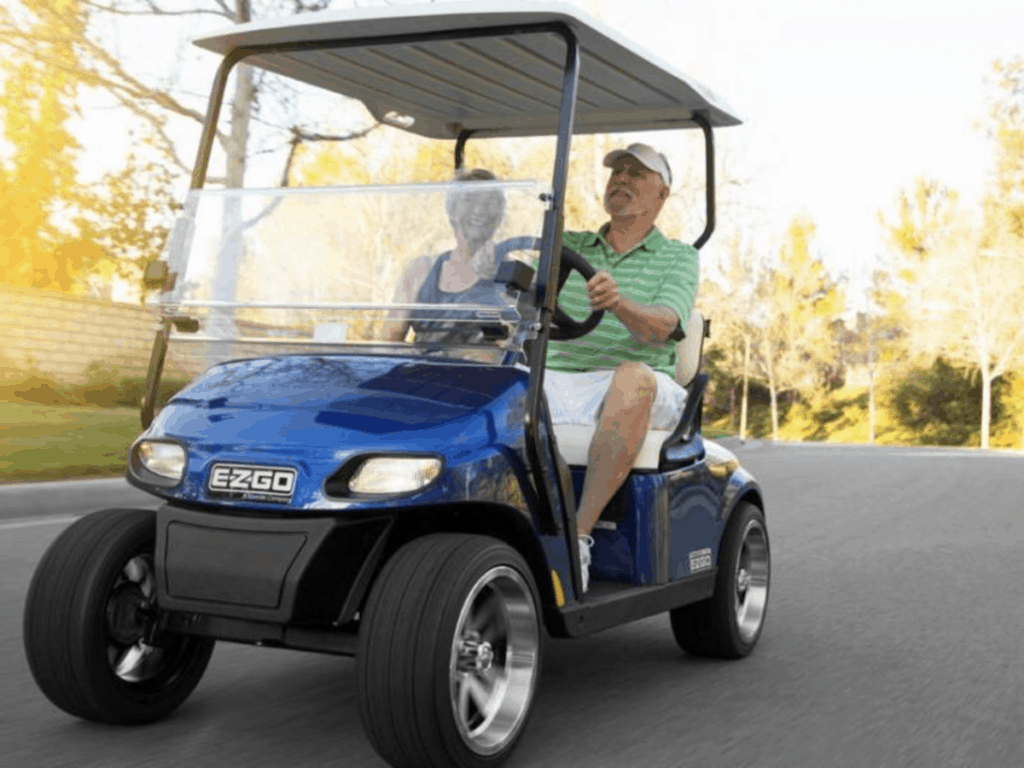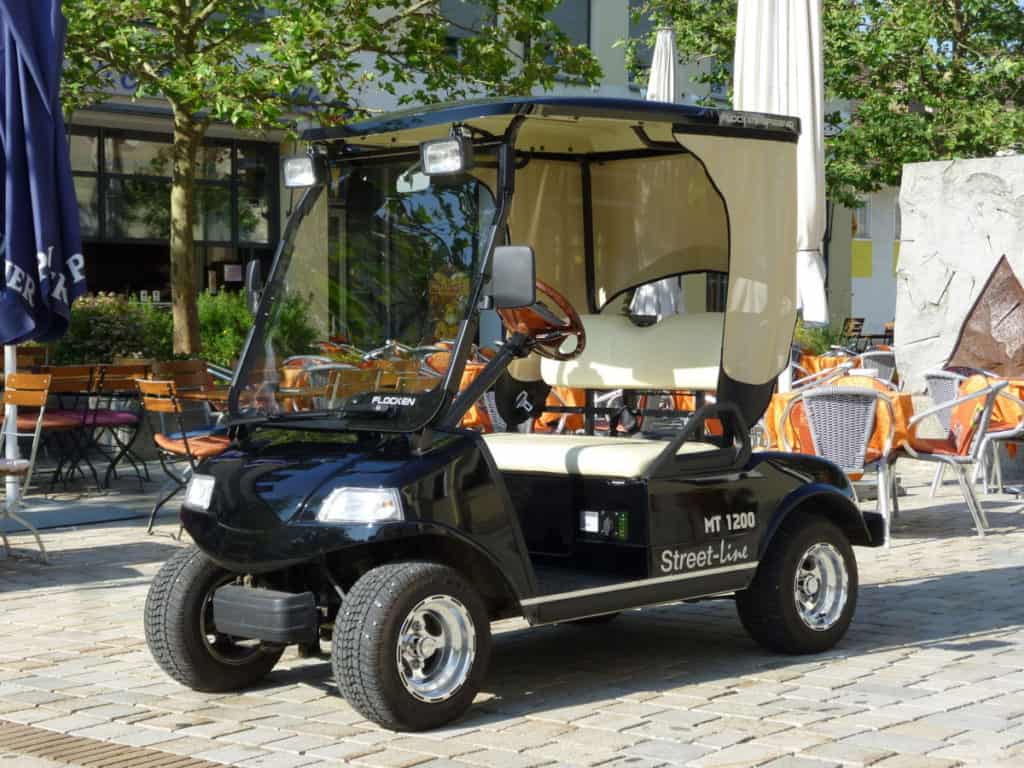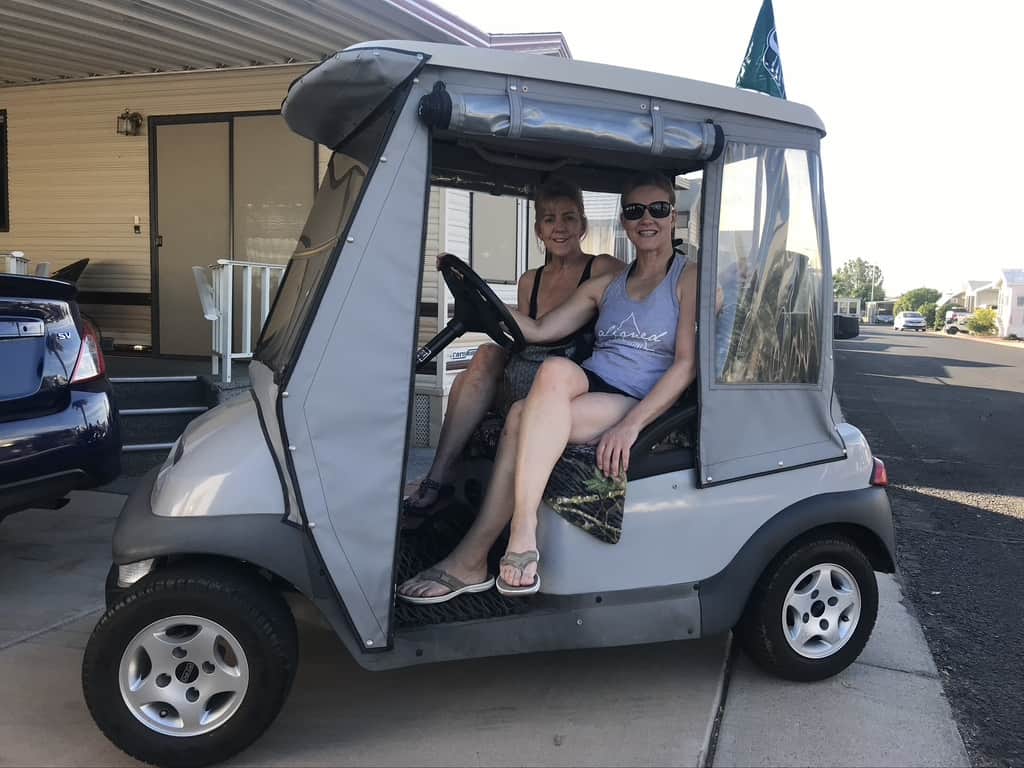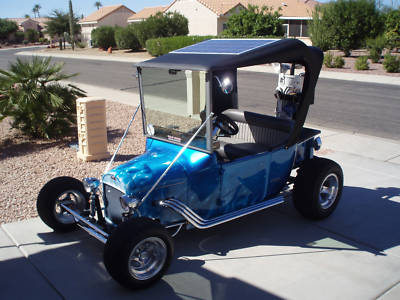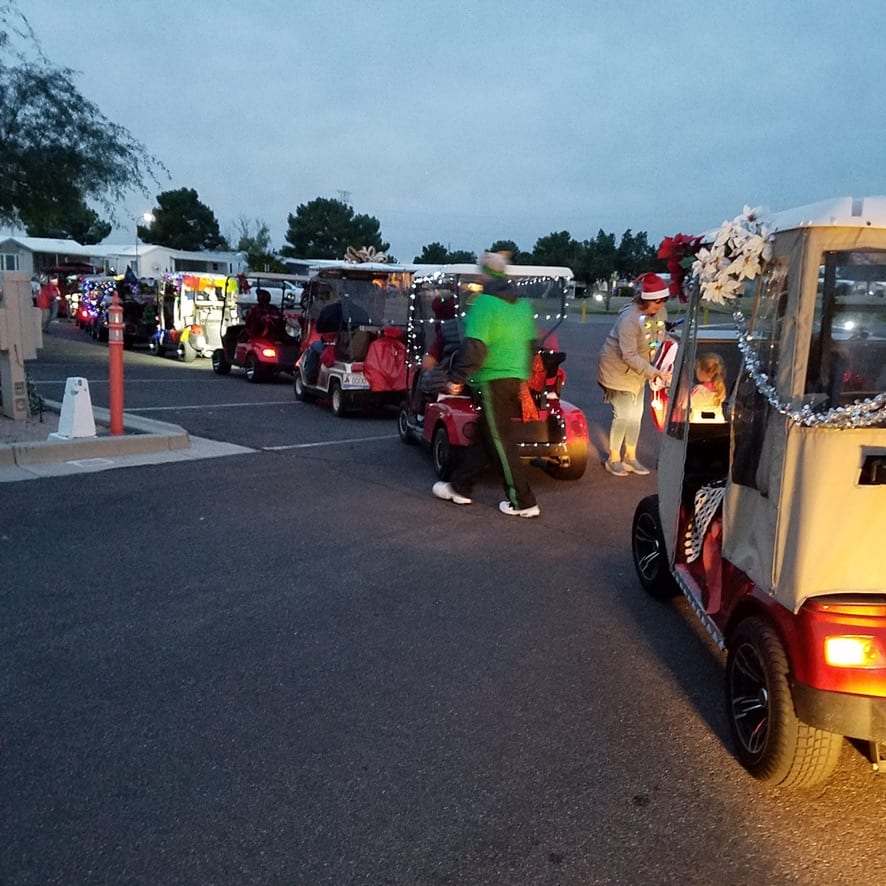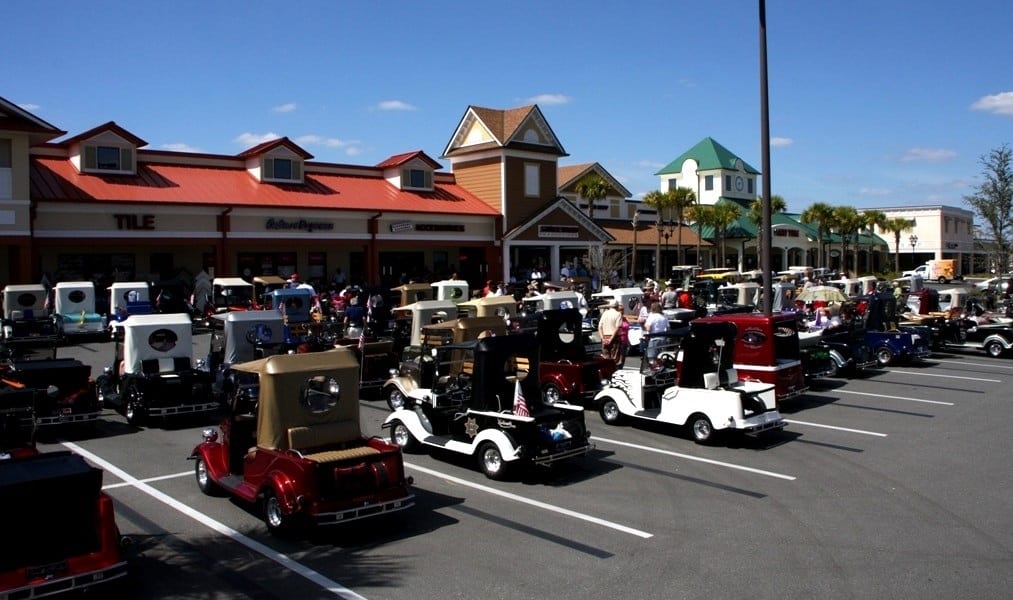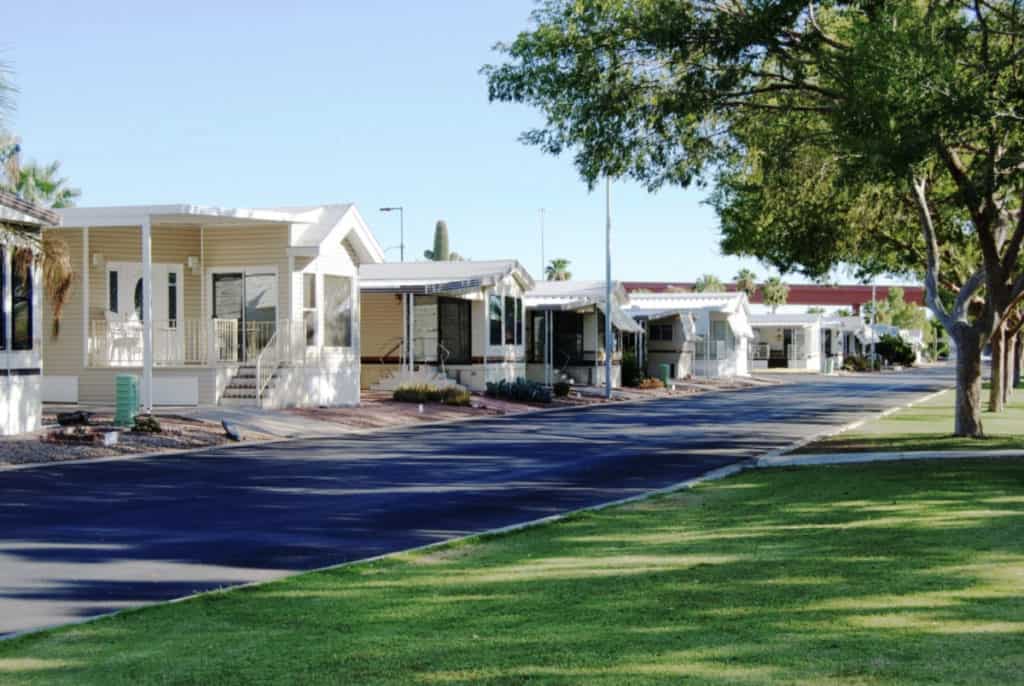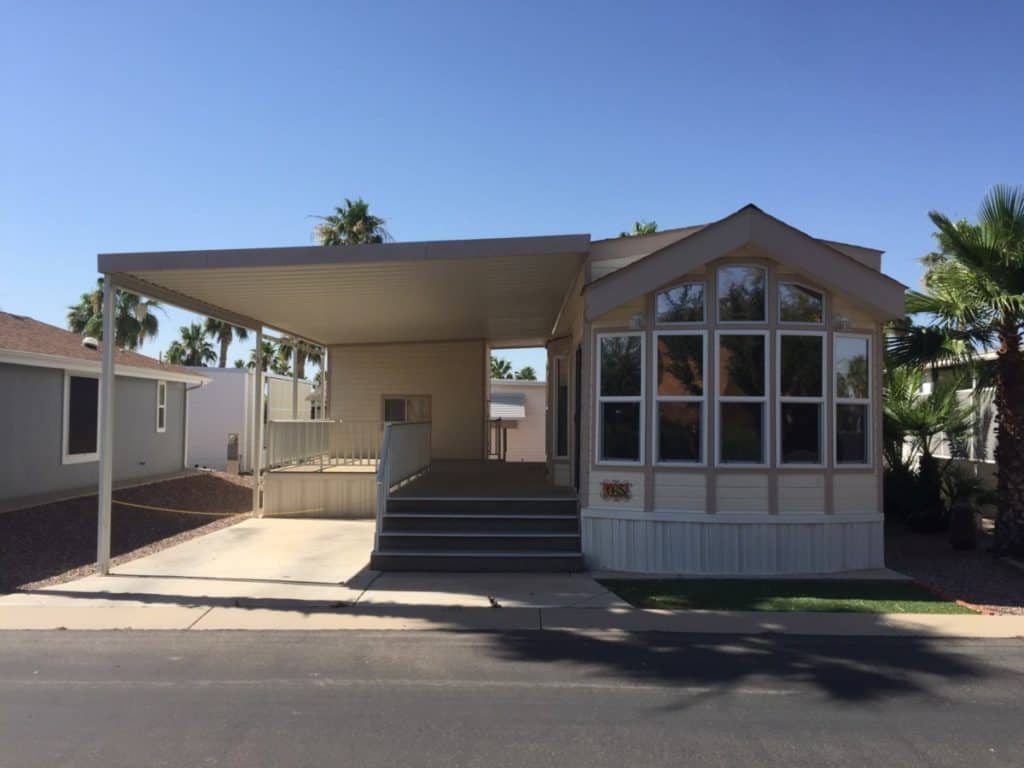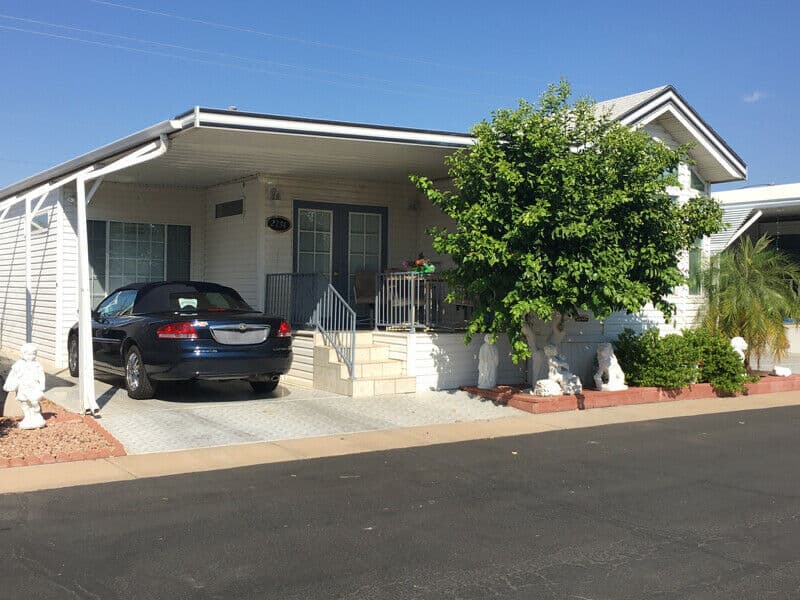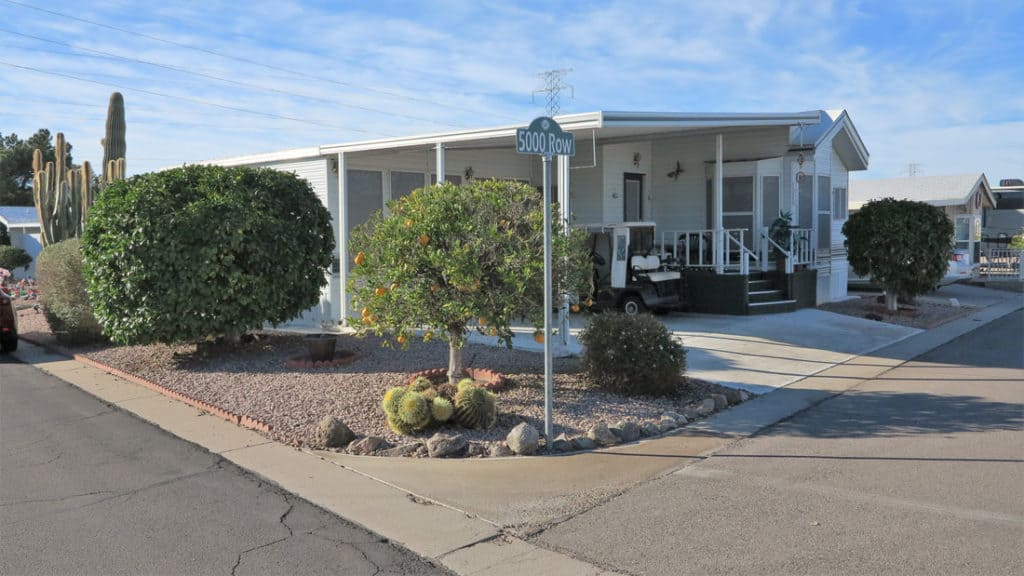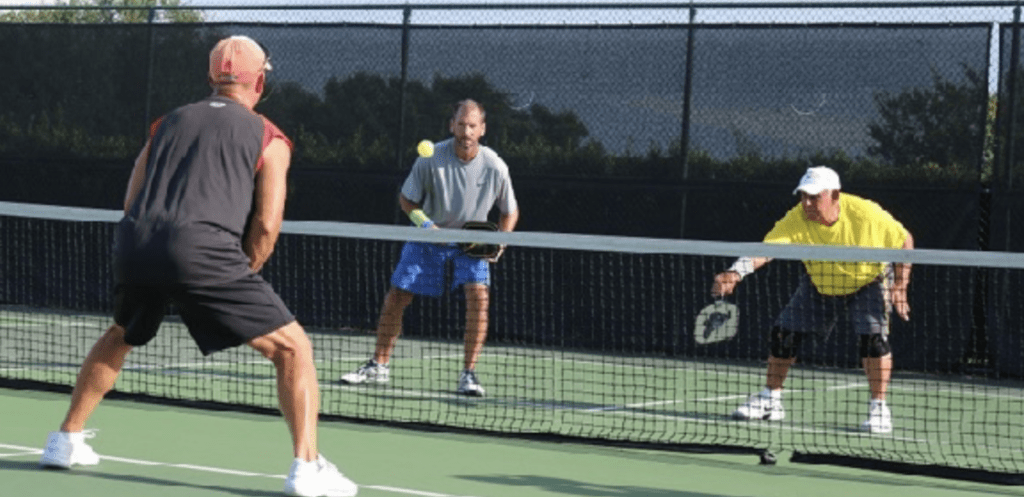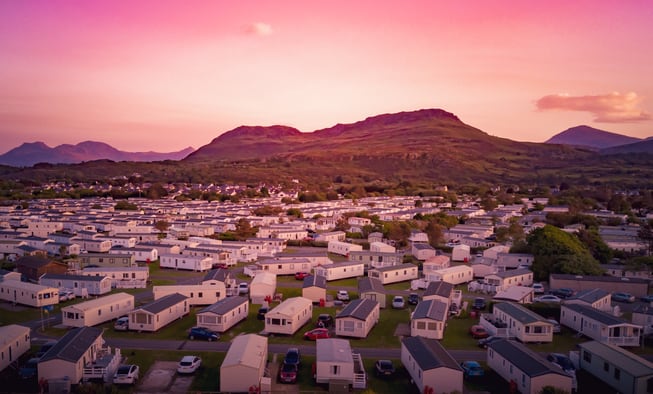Leaving your winter home safe for a hot winter requires knowledge, planning and some work. We’ve added best practices and tips from our own experiences and the experiences of many snowbirds designed around the specifics of park model and manufactured home living. Follow these steps and you’ll come back in the fall without any needed repairs inside or out.
The ravages of desert heat, wind and sand requires that you humidify, seal drains, prepare appliances, protect home and belongings against direct sunlight, seal and lock windows, take action against termites and bugs, and prepare golf carts and vehicles to avoid melted tires and damaged batteries.
Preparing your park model trailer or manufactured home for the heat of the desert in summer is much different than most Snowbirds have ever experienced before. Weather in the desert summer is hot, hot, hot… and dry too. With windstorms and sandstorms too. But we found comfort in what we’ve learned. It’s so nice to prepare and forget. We simply don’t worry anymore because we’ve prepared and use the knowledge and plan below.
HOT, DRY, DUSTY WEATHER IS WHAT DRIVES YOUR SUMMERIZING PLAN
For most of us that live in winter climates it’s difficult to appreciate just how hot, how dry, and how nasty summer really can be in the desert climate of the south. We now genuinely appreciate how tough those that remain in the parks year round truly are.
With summer temperatures approaching 120°F at times and dry summer sand storms approaching from time to time one has to be prepared. After all, we are leaving our pride and joy winter home to endure through all of this until we return in the fall. Each of us wants to return to a place that isn’t damaged and is move-in ready.
Keep in mind that with outside temperatures of 110 to 120°F the inside of your trailer home is much, much hotter. The coverings on the walls, plaster, and even some of the cabinet, countertop and wood surroundings can be damaged. This heat coupled with lack of humidity can serve to quickly sap needed moisture and warp wood products.
We found that the most interesting summer weather phenomenon were dust storms that are also called “haboobs”. These unexpected, unpredictable sandstorms can sweep across the Arizona desert landscape at any time and they are huge. (source: Arizona Emergency Information Network)
Weather drives your preparations. Below you will find actions that you can take to be comfortable knowing park model or manufactured home in the heat and storms of summer will be okay.
PREPARING INSIDE YOUR SNOWBIRD HOME
Much of what happens inside to prepare for your departure happens in the one or two days before you leave. Let’s step through each one.
Keep Those Awful Smells from you Refrigerator and Freezer
Regardless of whether you are going to leave your power on all summer or not clean your refrigerator and freezer before you leave. Empty it, clean it well, add some baking soda or coffee grounds in dishes to help absorb the odours. Make sure that you’ve propped open the doors. Doing this will ensure that you haven’t got a lingering smell for months trapped inside the refrigerator or freezer doors that will surely seep into the plastic.
Tip: Put a small cushion or something soft in the door of the refrigerator and freezer. Sticks, brooms, or hard items have been known to crack the plastics inside when bumped by anyone walking by.
Avoid Damaged Battery Powered Devices
Remove batteries from remote controls, clocks, smoke alarms, and other devices. This will ensure that they don’t overheat, swell and leak into electronic equipment. Put them in a plastic container with a cap on it in the cupboard. When you return in the fall it’ll be easy to retrieve and if they still are in good shape you’ll be able to reuse them with ease.
Add Moisture to Indoor Air
If you intend to leave your air conditioner off all summer long like many do it’s imperative that you provide some moisture to the air. Not doing so may damage some of your trailer perhaps warping walls or drying and cracking wooden furniture or trim.
“On a hot summer day indoor temperatures can easily be 20-30°F hotter than outside.”
An easy and effective method that many use to humidify the air is to put 3 or 5 gallon ¾ full water buckets in every second room or so. Some will use gallon-size milk containers but we like the added benefit of a larger bucket. Your local Home Improvement store sells a 3 or 5 gallon bucket for approximately $3. The first year we returned in the fall after a hot summer we noticed the buckets were completely dry and had been for some time. Be sure to tell your caretaker to refill the buckets should they need to be refilled. It’s cheap insurance.
Tip: Avoid circular rings on your flooring and put a folded towel under each water pail.
Summers Can Bring on Sewer Smells if You Don’t Close Your Water Traps and Drains
None of us want to come back to a home that smells like a sewer! The p-traps under your sinks and built into your toilets are there for that very reason. Soaring indoor heat will evaporate the water in the p-traps very quickly as your home. Before you leave, fill them completely with water and cover them completely.
To keep evaporation from the p-traps to a minimum cover the toilet bowls completely with plastic wrap and pour a little cooking oil into each sink drain. The cooking oil will not evaporate nearly as quickly as water. Then either tape over the drains themselves or fill a small balloon full of water and place it over the drain hole to reduce drain P-trap evaporation. After that, be sure to tape over the air holes near the top of each bathroom sink.
TIP: Don’t forget to remove the plastic wrap from the toilet bowl before you use it again! LOL
As an alternate approach, you may wish to just have your caretaker run the water into the drains every two weeks or so to ensure they don’t dry up.
“Our first year we came back in the fall to the awful smell of sewer. From then on we filled up the traps with water and covered them with small water balloons. Our caretaker runs a little water in each sink and flushes toilets every two weeks. Balloons are set back on top. We’ve never had a problem since.”
Keep out the Sun and Heat With Window and Door Preparations
Wherever possible Windows should be covered to prevent direct sunlight from damaging your belongings inside the trailer and reducing the heat the trailer will be exposed to. Some trailer owners cut aluminum foil and put it on the windows or hang sheets or curtains inside each. Be sure to check with your HOA or your trailer office regarding the rules as some discourage this. That said, inside blinds should definitely be closed and external window coverings checked to make sure they are fastened correctly.
You Won’t Spring a Leak While Away If you Shut Off the Water Supply
This is optional.. Some owners shut off the water at the water supply behind the trailer and others leave it all on all year round. If you intend to have your caretaker add water to your drains and water to your buckets you may wish to leave it on year round. If you do choose to turn it off look for the main supply valve near the back of the trailer. Often, it will be labelled with your site number on it. Some people advise leaving the water on to protect the pipes. Others do not.
Water heaters need your attention at this time too. Some owners drain the water heaters and others do not. We are believers in draining the water heater, flushing it at that time, and bypassing the water supply from the water heater. We’ve seen a failed water heater in a park model home before and we want to minimize the potential of a water heater failure in the summertime that would leave our trailer flooring and much of the contents damaged severely.
TIP: Bypass the water heater using the valves in your water heater door then drain your water heater before leaving. It is so easy to do and lessens the chance of a water heater failure that floods your indoors while away.
We understand that some people choose to leave the power on all summer long. Keeping the power on and the air conditioning on somewhere between 85 and 90°F is a common practice on more summer-vacated expensive homes in southern climates. However, this is a costly added expense that most simply avoid. Park-based park model trailers and manufactured homes are often left with the power off from spring to fall.
One of the last things you should do before departing for your northern summer is to flip off the main breaker in your breaker panel or, even better if possible, the main breaker or power feeds into the home.
TIP: Some power utilities require you to confirm that power is off or safe to turn back on before they do. If you shut off the main breaker when you leave for the summer you don’t stand the risk of concerns or problems when you arrange for your power to be turned back on.
A week or two earlier you may have arranged to have the power company or park disconnect your power sometime after you depart so that you don’t receive any power chargers anyway during the summer months while you’re away. If after you depart you realize you have not informed your power supplier to suspend or disconnect your power for the time that you’re away just give them a call. Some power companies allow you to go online to do this if you prefer.
TIP: turn off all appliances, unplug electronics, and lights before turning power off to your park model or manufactured home. This will reduce chances of your electronics being damaged from power spike or surges when you turn the power back on in the fall.
OUTDOORS NEEDS SOME ATTENTION TOO
Your Plants, Trees, Shrubs, and Cactus will miss you when you’re gone
If the responsibility for outside permanent plants are yours and not the park or the HOA be sure to begin your effort to care for them in advance of your departure date. A week or two before you depart it is ideal if you do the necessary trimming and clean up around your yard so that you can have trimmings in the trash and picked up before you go.
TIP: In Arizona Saguaro Cactus are protected. Cut one down and you go to prison. Ouch! – Arizona Revised Statutes
Avoiding Melted and Paint-peeled Outdoor Furniture
The summer sun and heat can have a devastating impact on anything you leave in the yard. UV rays and blistering heat can melt some plastics and paint will peel with ease. Be sure to put away your furniture and decor in a safe place out of the sun, summer winds and dust storms.
Some of our neighbours have small fountains they can easily be put away before summer comes. If you do too, consider adding some sanitizer to the water for a day or two to clean it up before it is shut down and drained then put away for the summer.
Those Termites and Bugs Can Hardly Wait Until You’re Gone
Those pesky termites are determined at the very least they’re prone to destruction, and so taking action to penetrate the ground around your home with termite deterrent is extremely important. You need to dig a trench, add the liquid deterrent, and then cover the ditch. See you local yard care center for the best products to use in your area. Most residents hire this small task done. We do. Take care if you intend to do it yourself. Precautions are necessary for your health.
“Our first summer we (one of us) left two extra fresh 2×4’s at ground level under our deck following a recent renovation. That’s like candy to termites. We got lucky and didn’t see any sign when we realized the next fall what we had done.”
TIP: Store fresh raw lumber away from your home or indoors over the summer.
At the same time we take precautions against termites we also make sure to spray for ants and other bugs. There is so much to appreciate about a concrete pad that Park Model trailers are often set on. The concrete pad not only provides a structural base to safely support and level the trailer but it also presents a barrier to many bugs and termites. Bugs come from anywhere but termites come from the ground.
Spiders and ants can also be a concern in some places. Scattering fabric softener sheets is a precaution that some swear by. However, many others don’t take this added step. Keeping food out of an unoccupied park model or manufactured home and ensuring its clean is often the best deterrent to these small pests.
CARS AND GOLF CARTS CAN REALLY SUFFER IN THE HEAT
Don’t Let Your Concrete Drive Reinvent the Wheel
Tires on hot concrete melt! Protect your car and golf cart tires from flat spots or irreparable melting by putting pieces of carpet or wood under each tire. Pull up within 12 inches of where you want to park, put the carpet pieces in front of all tires and drive forward. Double up the carpet for extra protection. Avoid the “thump, thump, thump” of flat spots on cart or vehicle tires come fall.
One long time park resident once told us a story about his first year. He parked his car in his carport for the summer with nothing under brand new tires. He came back in the fall to find black pools of rubber under each tire. Ouch!
TIP: Consider putting your golf cart up on blocks. In addition to saving tire damage it may extend suspension life a bit while acting as a bit of a deterrent to wanna be thieves. You could, with great caution, do the same for your car if your park or HOA permits.
Vehicle and Golf Cart Batteries Don’t Stand a Chance Without Preparation
It’s really important that you take the necessary steps to make sure that lead acid batteries in your car and in your golf cart are:
- topped up with water,
- fully charged, and
- disconnected from the vehicle.
They can be left in the vehicle but should be disconnected. Be careful while you’re doing this to make sure that you do not short out any circuits. This can result in a dangerous explosion. If it all possible, although this is not always necessary, have your summertime caretaker top up the batteries with water. Doing this will ensure that the lifetime of your battery certainly be maximized.
TIP: get and install a golf cart watering system for your batteries and ask your caretaker to take 2-3mins once or twice a summer to hook up the distilled water pack and let it refill.
Those Jugs of This and That in Your Shed Can Present a Real Risk
Some park model trailers and manufactured home owners may store gasoline or solvents in their garage, carport shed, or under the deck. This can be very dangerous and has to be done with caution and only if allowed by your park or HOA regardless of the time of year. As you prepare to leave for the summer remember the the added heat that these containers will experience may cause them to swell considerably and perhaps overpressure and possibly leak or explode. We never leave flammable liquids in containers over the summer. Be careful storing paint thinner, gasoline, BBQ charcoal starters, etc. It’s often best to just dispose of them in a legal and responsible way before you leave.
MAKE SUMMER PEACEFUL… WITH A RESIDENT CARETAKER
It’s very common for a caretaker to drop by your trailer or manufactured home every two to four weeks to:
- refill the water jugs so that your trailer is well hydrated
- add a little water to the drains or ensure the plugs are in place
- check the windows the entire property for damage
- walk around the home to check for wind damage
- ensure that windows and doors are locked tight to keep out wind, rain and dust.
This peace of mind is worth every penny.
TIP: Some caretakers send an email report and pictures each walk through. They’ll also arrange for any needed repairs on your behalf during your absence.
Most residents have contract caretakers that watch over their property all summer long. Often, they’ll usually do this for between $10 and $25 a month. Truly a small price to pay. They are usually park residents that reside there year round and they know Snowbird park model trailer and manufactured home living very well.
CONSIDER REMOTE SECURITY AND MONITORING SYSTEMS
Few actually do this but we’re sure more will in time considering the low cost of wifi cameras, thermostats, and alarm systems. Just keep in mind you’ll have to leave your power and internet on to do this and it isn’t possible to reset or reboot any problematic monitoring equipment if the need arises. Be sure to test the system before you depart.
THE LAST FEW LITTLE THINGS YOU CAN’T FORGET TO DO
You may want to consider a week or two before you plan to depart to arrange to have your mail and any other deliveries forwarded or stopped.
If you have cable TV or satellite service that you wish to suspend service for the summer. Keep in mind that some of the services may require at least 30 days advance notice and the service may allow you to suspend service rather than cancel. So be sure to ask which would be best in your situation.
In addition to the support for utilities the park that you stay at often wants to know if you are there or not. For many reasons this helps them plan and protect your interest. Before we depart for the summer we just go up to the park office and let them know that we will be departing and that our home will be uninhabited for the summer.
At the same time let the park know who your caretaker is in case they need access to your trailer for any reason. If you are in a homeowners association they may want you to notify them too. Often, they will also want to know when you expect to be back. “As soon as it snows up north” is a common response!
As your departure day approaches you may find yourself out of sync with when that garbage and recycling needs to be put out. Try your best and if necessary turn to a neighbour and ask for them to put the garbage out on your behalf and bring the been back to your site. Or paid it forward for someone else. Then strap or rope the bins down to keep them from flying away in a summer wind. You don’t want anything you leave outside flying into a window in a sandstorm. On top of a damaged window you may have sand and rain inside in a few short minutes.
Finally, be sure that you have protected the valuables that you intend to leave there. For instance, jewellery, documents and things that you could not bear losing should be put in a local safety deposit box at the bank. You’ll rest easier.
CONCLUSION
Preparing to leave your winter Snowbird home to return north for the summer doesn’t have to be a big job. After a few times you’ll have it down to a science. As you look to your Snowbird home summer weather from time to time you’ll rest well knowing you’ve prepared it for the heat, wind, rain, and sandstorms. Take precautions indoors, outdoors, with cars/carts, and hire contract onsite caretaker to give you peace of mind.
